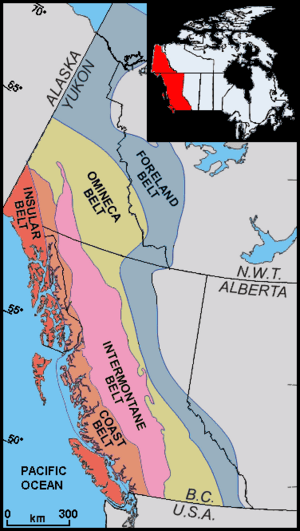Insular Belt facts for kids
The Insular Belt is a special area along the northwestern coast of North America. It's a unique geographical region made up of large and small islands. This belt stretches from southern British Columbia in Canada all the way into Alaska and the Yukon territory.
This region is important because of how it was formed. It's like a giant puzzle piece that joined the North American continent a long, long time ago, between the Late Cretaceous period and the Eocene epoch. This process is called accretion, where land masses slowly come together. The main part of this puzzle piece is known as the Insular Superterrane. It's actually made up of several smaller land pieces, called terranes, that joined together over time before attaching to North America.
What is the Insular Superterrane?
The rocks that make up the Insular Superterrane are considered allochthonous. This is a fancy word meaning they didn't originally form in the same place as the rest of the North American continent. Imagine them as travelers from far away!
These rocks are a mix of different types:
- Volcanic rocks: Formed from ancient volcanoes.
- Intrusions: Rocks that cooled and hardened underground.
- Sedimentary rocks: Formed from layers of sand, mud, and other materials.
All these rocks came from an ancient chain of volcanoes in the ocean, like a string of islands, called the Insular Islands. Scientists are still trying to figure out the exact details of how these islands crashed into and joined the North American continent. It was a very slow and powerful collision that shaped the land we see today.
Islands of the Insular Belt
The Insular Belt includes three main groups of islands, along with many smaller ones. If you travel from south to north, you would find:
- Vancouver Island and the Gulf Islands in British Columbia, Canada.
- The Queen Charlotte Islands (also known as Haida Gwaii) in British Columbia, Canada.
- The Alexander Archipelago in Alaska, United States.
These islands are home to amazing landscapes and unique ecosystems.
Unique Features of the Region
The Insular Belt is known for its dramatic landscapes. It has some of the biggest changes in elevation, from deep underwater areas to very tall mountains. For example, the Queen Charlotte Sound was once a flat coastal plain during the last ice age, but now it's a deep body of water. Nearby, you find the towering Wrangell and Saint Elias Mountains.
Most of this region is very rugged, meaning it has lots of mountains, hills, and valleys. There isn't much flat land, except for a few specific areas like the eastern coast of Vancouver Island.
The Insular Belt also has a mild, temperate climate all year round. This means it doesn't get too hot or too cold. Because of this climate, the region is covered in thick forests. You can find some of the world's largest and oldest trees growing here, making it a truly special place for nature lovers.


